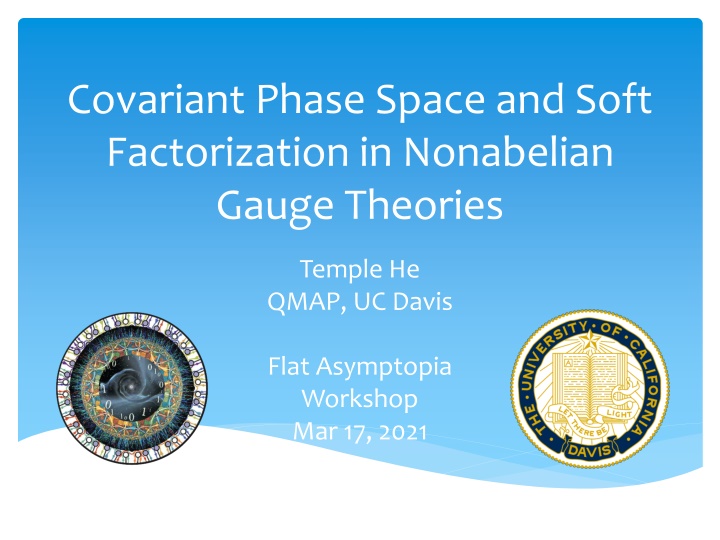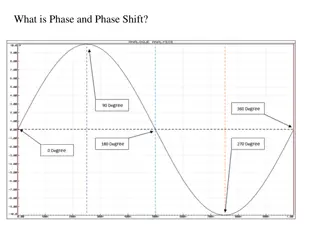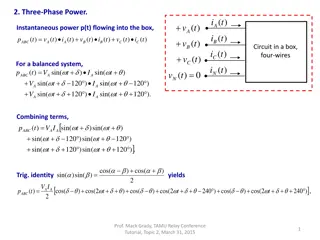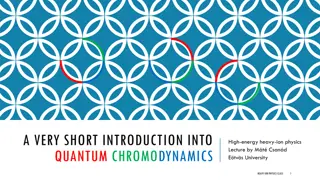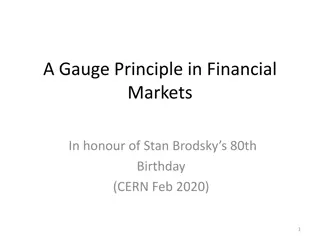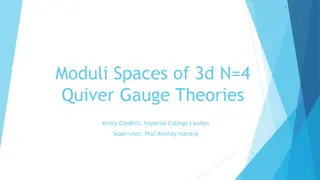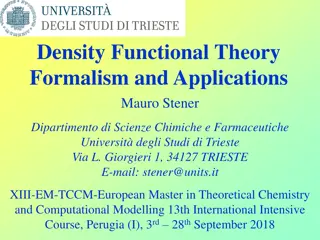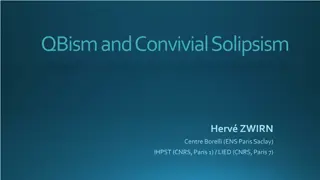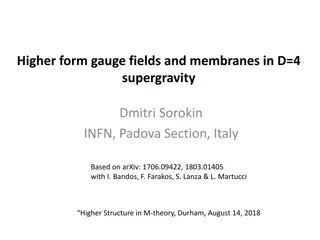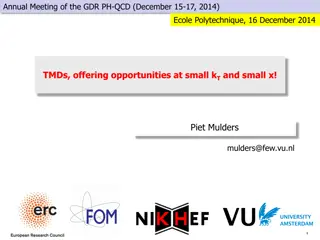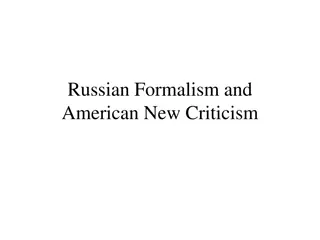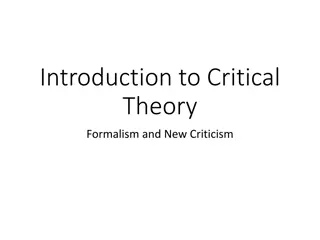Covariant Phase Space Formalism in Nonabelian Gauge Theories
The presentation focuses on the covariant phase space formalism in nonabelian gauge theories, aiming to derive the symplectic form and Poisson/Dirac brackets systematically from the Lagrangian. By applying canonical quantization methods, the structure of the infrared sector in such theories can be deduced. Canonical transformations, Poisson brackets, and Ward identities are key components explored in this study.
Download Presentation

Please find below an Image/Link to download the presentation.
The content on the website is provided AS IS for your information and personal use only. It may not be sold, licensed, or shared on other websites without obtaining consent from the author.If you encounter any issues during the download, it is possible that the publisher has removed the file from their server.
You are allowed to download the files provided on this website for personal or commercial use, subject to the condition that they are used lawfully. All files are the property of their respective owners.
The content on the website is provided AS IS for your information and personal use only. It may not be sold, licensed, or shared on other websites without obtaining consent from the author.
E N D
Presentation Transcript
Covariant Phase Space and Soft Factorization in Nonabelian Gauge Theories Temple He QMAP, UC Davis Flat Asymptopia Workshop Mar 17, 2021
Collaboration Main focus on 2009.14334, done in collaboration with P. Mitra
Goal of presentation Covariant phase space formalism A systematic way of deriving the symplectic form given a Lagrangian and deducing the Poisson/Dirac brackets Canonical quantization Standard method of elevating fields to quantum operators and Poisson/Dirac brackets to commutators We would like to apply these two techniques to nonabelian gauge theories and deduce the structure of the infrared sector of such theories.
Outline of presentation Introduce the covariant phase space formalism Review relevant aspects of symplectic geometry Apply to nonabelian gauge theory Lagrangian and deduce the symplectic form Obtain the Dirac brackets Perform canonical quantization and construct the vacuum sector Obtain a Ward identity, which yields the soft gluon theorem as a corollary
Phase space A phase space is a symplectic manifold endowed with a closed, non-degenerate two-form called the symplectic form. Assuming is topologically trivial so that all closed forms are exact, there exists a one-form called the symplectic potential such that
Canonical transformations Canonical transformations are a special class of transformations that preserve . They are generated by Hamiltonian vector fields Xf with Hamiltonian charge f so that Because is invertible, we can derive
Poisson brackets If Xfand Xgare Hamiltonian vector fields, [Xf,Xg] is also a Hamiltonian vector field. The Poisson bracket {f,g} is the Hamiltonian charge corresponding to [Xf,Xg]. Using this, we can derive the bracket to have the nice form
Covariant phase space formalism The covariant phase space formalism allows us to construct the phase space given a Lagrangian. Given a generic Lagrangian L, we can vary it w.r.t. an arbitrary vector field X in configuration space to obtain The Eiare equations of motion, and is a one-form in configuration space. We restrict ourselves to Ei=0.
Pre-symplectic form The symplectic current density is defined as This is a closed two-form on the solution space, and the pre-symplectic potential and form is defined as We still need to check invertibility.
Symplectic form To ensure invertibility, we identify the kernel of the pre-symplectic form and quotient it out, i.e. we identify all elements in the solution space related by a vector in the kernel. A useful way of quotienting out these redundant states is via a gauge condition
Nonabelian gauge theory We apply the formalism introduced thus far to a nonabelian gauge theory, with Lagrangian We apply the covariant phase space formalism described earlier to write
Gauge transformations Infinitesimal gauge transformations are generated by It is easy to show that Do they lie in the kernel of the pre-symplectic form?
Small gauge transformations From the boundary term in the variation of the Lagrangian, we can deduce the pre-symplectic form. After some algebra, one can derive Thus, if vanishes on the boundary of the Cauchy surface, then the above expression vanishes. These are precisely the small gauge transformations.
Large gauge transformations Large gauge transformations do not have =0 at the boundary. In fact, if is independent of field variables, It can be shown that this is precisely the form of a canonical transformation, so large gauge transformations are canonical. This is why we don t allow to be field dependent.
Isometries Given Killing vector fields , the isometries are generated by We can then derive Note that we require the boundary integral to vanish in order for isometries to be canonical.
Coordinate system We now assume we are in a 4D Minkowski spacetime, and that the symplectic structure on I+is the same as that on I-. We also assume all states are massless.
Boundary conditions We want the fields to fall off fast enough so that the charges are finite. This implies we want the energy-momentum and angular-momentum flux to be nonzero but finite.
Example: scalar field Consider a massless scalar field given by The null energy flux through I is given by The falloff condition is then
Gauge field falloffs Similarly, we can determine the large r gauge field falloffs to be The boundary falloffs also ensure that isometries are canonical. We will henceforth work in the Au=0 gauge.
Boundary condition on i0 It is traditionally assumed that These are too strong for us, since it is not preserved by LGTs, thus excluding LGTs. We instead propose This places a constraint on the phase space.
Symplectic form of gauge theory Our theory has the Lagrangian Using the techniques earlier, we can determine the symplectic form to be
Introducing constraints The constraint we imposed at spatial infinity can be written as We introduce the boundary fields With this constraint, the symplectic form is no longer invertible.
Symplectic form The soft part of the symplectic form in these new coordinates become Note that the following vector belongs to the kernel:
Another gauge condition We must identify the field Nzso that This is most conveniently done via the gauge condition We can then write
Final symplectic form The full symplectic form is Thus, the phase space factorizes as
Dirac brackets We can invert the symplectic form to derive the Dirac brackets
Canonical quantization We promote classical fields to quantum fields Dirac brackets become quantum commutators, and complex conjugation becomes taking the adjoint. Factorization of the phase space implies a factorization of the Hilbert space:
Hard sector The hard sector includes the fields ? and , and is given by a Fock space with C+A operators given as
Vacuum state The vacuum state is defined to be the states that are annihilated by all annihilation operators, i.e. for p>0 As we will see on the next slide, this vacuum state is not unique. The hard Hilbert space is obtained by acting on the vacua with creation operators.
Soft sector The soft (or vacuum) sector includes the fields C and N, as they commute with the Hamiltonian. The C fields commute, so the soft Hilbert space is spanned by the eigenstates of C, i.e. The vacua are normalized so that
Soft sector Using the algebra between C and N, we derive the action of N on a vacuum eigenstate to be where Note that the resultant state is not an eigenstate.
Standard QFT vacuum From the symplectic form, we can derive the LGT and isometry charges, which act on the vacuum via Importantly, most vacua states are not Lorentz invariant. However, U=1 is Lorentz invariant, and we assume this is the standard QFT vacuum.
Large gauge transformations The charge that generates finite LGTs is When acting on a vacuum state, we show that Thus, an LGT takes one vacuum eigenstate to another with eigenvalue gU.
S-matrix elements The S-matrix is given by Using the LSZ reduction formula, we derive for a positive helicity gluon
S-matrix elements When energy is nonzero, we obtain When energy approaches zero, we obtain
Deriving the Ward identity Begin by noting that This immediately implies which in turn implies
Deriving the Ward identity Using the fact we know how LGTs act on the vacuum, we obtain The final Ward identity is thus The RHS can be evaluated using Feynman diagrams.
Corollary: Single soft theorem The single soft theorem is To deduce this from the Ward identity, recall that
Corollary: Single soft theorem We can deduce how Nzacts on the vacuum based on how N acts on the vacuum. The final result is This is the soft theorem in an arbitrary vacuum, and setting U=1 immediately recovers the familiar single soft gluon theorem.
Summary We applied the covariant phase space formalism carefully, keeping track of boundary terms, to a gauge theory. We performed canonical quantization and showed that the Hilbert space factorizes into a hard sector and a soft sector with infinite vacuum states. We derived a Ward identity for computing S-matrix elements between arbitrary vacua, and the familiar soft gluon theorem is a corollary.
Ongoing research Using the same method, we can derive consecutive multiple soft gluon theorem from the Ward identity, but we are unable to derive the simultaneous soft gluon theorem. We are currently working to understand the simultaneous soft limit as a Ward identity.
